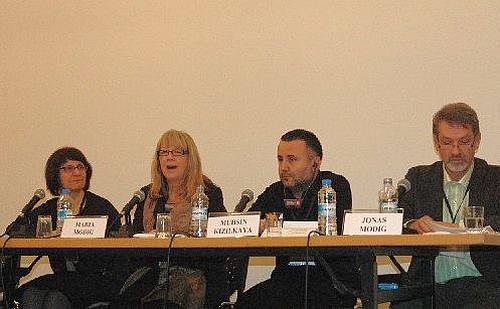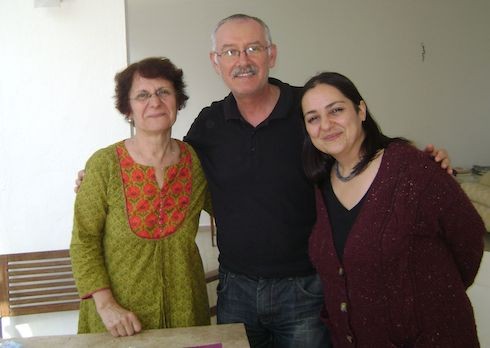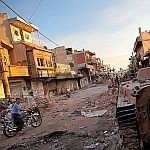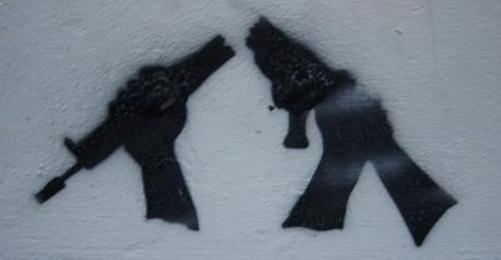I have suddenly come across with Azar Mahloujian, a female writer from Iran, in Gümüşlük Academia.
In 1982, she fled to Sweden after going past the snowy mountains of Iran through Turkey. While she lived in Sweden as a “refugee”, her mind, heart and eyes have always been on Iran.
Now she is a world citizen. Now every land is her country and every people are her people.
The fact that we have met before came to my attention later on. She was one of the international guests of a conference dedicated to our beloved friend Mehmet Uzun on February 17, 2007. Then, she first mentioned what it felt to be a writer in exile.
This time, we weren’t in a conference setting and had the opportunity to talk for a long while.
On the day that this interview will be published [April 19, 2014 in the Turkish version of bianet], Azar Mahloujian and I will be talking about a variety of issues in Gümüşlük Academia. She will read us excerpts from her novels and other writings.
I am sharing this interview with bianet readers in case they can’t make it to the conference and feel sorry about that.
You lived in Iran until the age of 33. Could you tell us about your story in Iran ? Your education and other things… What did you do in the past?
I was born in a town near the Caspian Sea. I came to Tehran after high school to study at Tehran University. I have completed my BA in English literature and MS in Librarian Studies. I was active in student movements during the shah and was arrested after participating in a demonstration against bus ticket hikes in Tehran, but I was released after 12 hours. I wrote about it in a novel “Do you love someone else?”
Before revolution I was working as an English teacher and later on as a librarian at Tehran University Library and other libraries, altogether for 8 years.
Why did you decide to escape?
It is a long story. After the revolution, we as young librarians, were fighting for democracy in the country like everybody else in different professions. We wanted to put an end on censorship. We had a big meeting and changed the charter of Iranian library association, adding paragraphs which stressed the library’s role as defender of freedom of speech and fighting censorship.
I was chosen as a board member of the new library association. Only two weeks later, the censorship of books began. The new revolutionary government gave order to the libraries to tear apart or burn the books of the shah (he wrote two books) and also first pages of the books which contained dedications to him. Our board wrote protest letters to the newly elected president (Bani Sadr) and also to the parliament saying that we as librarians could not burn books.
We were against the shah, but books belong to the history of the country, and the next generations need to know about the shah. They should be kept for example in a special room in each library and be accessible at least to researchers. But no answer came from the new government. Instead it gave a new order: books about Marx, Engels, Lenin, Stalin and all the Marxist literature should be taken out of the library. And the next order was of course all the books on Darwin and Darwinism.
We wrote more letters and participated in protest actions. Soon the newspapers were attacked and closed and little later all the political parties and groups were banned. So a new era of dictatorship began. It is why censorship is dangerous because it has its own life. You decide the time you begin the censorship, but you never can decide when you can put stop to it. It was my situation at the professional level.
On the other side, one year after the revolution Khomeini gave order to “Islamize” all universities in Iran. This action was called “Cultural Revolution” against all the universities because according to the government the teachers and students were on the side of the shah and were bought by CIA. In all universities there were protests and sit-in strikes. Students, teachers and also the staff were among the protesters. I was participating in the strike.
But after some days and nights of attack which resulted in the killing of some students in the whole country, they succeeded to close all the universities in two years. The students were not allowed to come to the university, but teachers and staff had to be at work (of course without any work to do!).
In the meantime the political situation became worse and Bani Sadr (Please remember, he was the first president of Iran after 2500 years of monarchy!) escaped the country. Then the government began mass arrest. They prepared lists of people who were active against the “cultural revolution”. I was on the list and one day on my way to work one of my colleagues met me at the bus stop near the library and warned me. “Do not come to the library. The revolutionary guards have been there and asked about your photo and home address!”
So I could not go to my work, I could not go to my apartment, I could not go even to my parents because they could easily find me. So I had to hide in Tehran. People gave me shelter. Many of them I met for first time, only through friends who were finding a shelter for me among their friends or relatives. I got an address and I went there to spend one or two nights, sometimes longer period. I am so grateful of all these people who saved my life in spite of the danger of being arrested themselves.
It was in a period when the Iran-Iraq war was going on and all basic food were ransomed. You should show your identity card to the people in the local mosques to get a coupon for wheat, rice, oil, tea, milk, chicken, soap, etc.
I was not in a situation to show my identity card and these people were feeding me in such a difficult situation. They were sharing with me their small amount of food. To see the generosity and also resistance of these people became a great lesson for me. I must add that my situation was not unique. I dare to say that hundreds of thousands of people were hiding; many had come from other cities and small villages to Tehran to hide themselves in the anonymity of the capital city.
After nearly six months, my resources became fewer, and it became more dangerous both for me and for the persons who helped me. So I decided to take the risk and leave the country illegally, by the help of smugglers.
Sorry. The story became long, but may be the people, especially young people, need to be reminded about these important events after the revolution.
You tell your escape story in “The torn pictures" published in 1995. After 23 years from leaving Iran. Why did you publish and why did you wait so long?
On the contrary of many writers who say they had been dreaming to become a writer from childhood, I had no ambition to become a writer. I was a librarian and was happy with my profession. In Sweden I tried to keep it and started working at Stockholm University Library (of course not as in Tehran where I worked as the chief of the library’s Reference section or chief of the periodical section.
In Sweden I was working at the library on inconvenient time, late evenings (4pm-10pm) which was too late and too cold to be attractive for the Swedish librarians. But I was happy with that. I was at least working in my profession.
One day I got the news: A 19-years old son of my cousin who did not want to be sent to the war front, was escaping Iran, the same way as I did some years before. He was going to be helped out through climbing mountains between Iran and Turkey to go later to Germany where his uncle lived. Some days after his escape, my cousin got a message from the smuggler: “Your son froze to death on the mountain. Come and get the body”. My cousin, a lawyer himself, hired a group of 10 mountain climbers to get the body down. When I heard the news I felt bad conscious, like many survivors of the Nazi concentration camps who ask themselves: “Why my life could be saved, but not the lives of 6 million others?”
I felt that my tears were not enough. It was a big tragedy and I should do something. I should tell people why such a young boy escape and come to their country. Why the parents are so “cruel” that they separate their children from themselves? Is it only for the luxury life in the West or it is because of real problems?
I wanted people to understand these “uninvited guests”. I wanted to write about him, but I did not know how he felt before he froze to death. I only knew how it felt under my escape. It was my testimony for the time we are living in. That was the reason I started to write. And I wrote it in Swedish. That was how the story began…

I know that you visited our country several times. What are the difference about Turkey from the first arrival in Van to now?
I was in Istanbul several times. As I wrote in “Torn Pictures”, first time as a refugee, unsafe and without any country to live in.
After some years, I came to Istanbul as an interpreter with a delegation of Swedish lawyers and social workers who interviewed Iranian refugee families and wrote a report for “Save the Children” in Sweden. Another time for the conference for my friend and colleague Mehmet Uzun, the Kurdish writer who lived and worked in Sweden and unfortunately died very young.
I was in Istanbul two more times on the way to Diyarbakir for the trial of Muharem Erbey. I was then representing Swedish PEN who had Mr Erbey as honorary member. Fortunately this time he is free and I am very happy. So as you see, I have a lot of different memories and impressions of Istanbul. I love Istanbul.
Last week when I was in Istanbul I went to see Gezi Park. Of course it was empty, but it has become a historical place. I think that many tourists who followed the Gezi Park Movement are going to add this park to the list of the places which must be visited in Istanbul. This movement gives hope, it created a network which is alive and can mobilize people when it is necessary. Istanbul is changed this time through this movement.
For me, another point about Istanbul is that Iranian still are obliged to escape to Turkey and live an insecure life as refugees in Istanbul. It is sad that Iranians still must do the same thing I did for 33 years ago.
What do you think about Iran today after leaving behind everything?
Iran today is a country of a majority who, like any other nation, dreams to live in peace and harmony with each other and with the neighbors, and a minority who has no other dreams than controlling the majority and show itself powerful in the region.
That is why the regime in Iran does not care about one million street children in Iran and instead sends money and military forces to help Beshar Asad to kill more of Syrian people, has ambitions in Afghanistan, and in Iraq and anywhere in the region.
It plays the dangerous game of cat and mouse with the western world, a game which endangers the safety of Iranian people. In many years Israel has been lobbying for a bombardment of Iran. The ordinary people in Iran have other problems to think of, far from the ambition of the regimes nuclear program. Inflation, joblessness, corruption, drug problems and prostitution are the problems which the regime does not care about. The regime only cares about keeping the power. That is the reason why all the critical press are banned, many journalists, workers and student leaders, human rights activists and women rights activists are prosecuted or imprisoned.
It is a sad story, but at the same time the young people, just those who are born and grown up under the Islamic The Republic’s propaganda are resisting. We have seen the uprising in 2009. We are going to see new uprisings. I believe that young people and also women are hope for Iran of tomorrow.
Freedom fighters were also facing things in the shah period. What are the similarities and differences between then and now?
Let me tell you something. Some of my friends’ children blame their parents about the revolution. They ask “why did you do this revolution? You had good life, you could have boy or girl friend, and you were free to choose your clothes, your life style. Why did you make life so difficult for us?”
The answer is that people who made the revolution and endangered their lives in the streets fighting against the shah, were not a group of masochists who wanted to make life worse. We dreamed a better life, but it became even worse. I believe that it is the shah to blame. If he listened to the opposition instead of sending them to the torture chambers in Evin prison, if he stopped the corruption of his regime, his family and deep social gap, then people would not make the revolution.
The young Iranians have not experienced the dictatorship of the shah. They have no idea of how corrupt the system was and how the freedom of speech was limited. The country was ruled by one- party system and people could lose job if they were not members of the shah´s party “Rastakhiz”(Resurrection).
But the difference between the shah and Khomeini is that the shah had no ideology. You were free to live as you wished, in Eastern or Western way, the only thing you should not do was to criticize the shah. But Khomeini made Iran an Islamic Republic. It means that Iran became a theocracy where the government interferes in the relation between the citizens (I wonder if we can use this term for people in a country where the rights of people are ignored) and their God.
Now the government looks in the people’s bedroom. Stoning to death is the punishment of those who are “bad” Muslims. The government decides if you are a “real” muslim or not. So this is the difference, but the similarity between these two era is, as I mentioned, the lack of democracy, I mean dictatorship.

Some claim that Turkey is a bit like Iran during that period. Do you really think so?
Yes, the similarity is that both governments want to promote Islam. The Iranian part is of course more successful and powerful because it gets its legitimacy from the people´s revolution, and also because it has governed the country in 35 years.
It is as if Erdogan has a hidden dream of making Turkey another Iran. It is worrying to hear about the Turkish government’s propaganda against abortion, that women should have more children etc. There are many other similarities. Look at the latest economical scandal which both Iran and Turkey were involved in. Corruption of the head of the two regimes seems to be the same.
The banning of twitter in Turkey is similar to ban of You tube and facebook in Iran. Jailing the critical journalists is another similarity.
During a period people thought that Erdogan was leading Turkey to democracy through Islam. But especially his regime´s reaction against Gezi park- movement showed that it was just an illusion. You cannot combine religion and politics and talk about democracy.
I visited Tehran in 2005. Two things caught my attention: first, the role and importance of women and two, is an urban society and culture. Would you agree with me on this? How do you explain that?
I agree with you. Women are the big problem for the mullahs. They are everywhere in the society. You can find women bus driver who work long distances between cities, they make 60% of university students, and they create art, films, write books, and fight for their rights.
In the West, people are astonished about what they see of Iranian women. They have difficulty to understand the contradictions. My answer is that the Iranian women were too strong to be treated as the women in Afghanistan or Saudi Arabia.
Otherwise, the mullahs would very much like to make them sitting at home, in charge of kitchen and raising children. But Iranian women had the experience of their mothers and grandmothers who were among the first women in the region fighting for women’s rights to education, to different profession, to vote, etc.
We should remember that during the 8-years war (at least one million men were killed) it was the women who had the responsibility for the family both inside and outside home. When men came back from the war front, it was too late to push women back to home. So women are fighting and I think they are headache for the regime.
I agree with you. The regime could not kill the culture. It is as if in Iran the regime goes its way and the people go their own way.
Thank you.
Thank you.
* Click here to read the article in Turkish.








